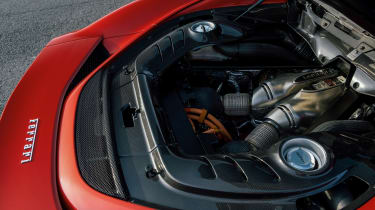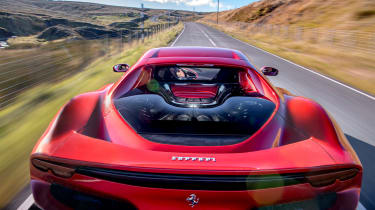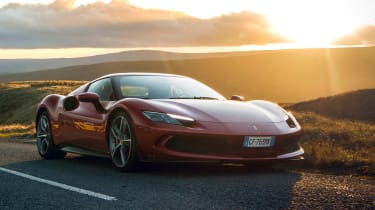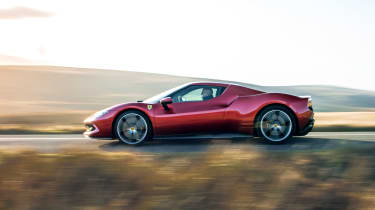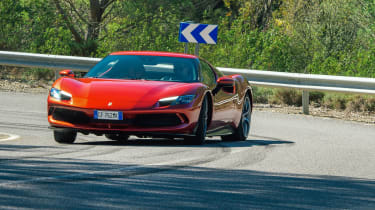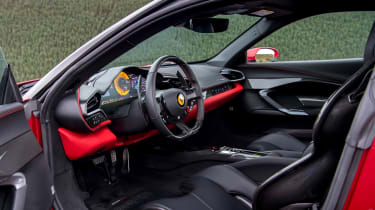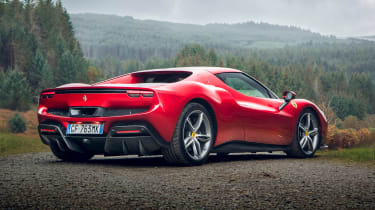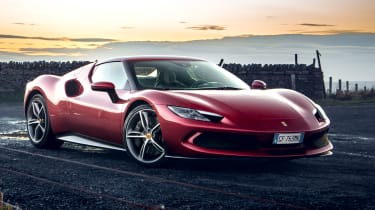Ferrari 296 GTB 2025 review – the car the Lamborghini Temerario has to beat
Ferrari’s V6 hybrid supercar has been with us for a couple of years now. It’s still mindblowing, even with a 10,000rpm, 903bhp Lamborghini rival on the horizon
Ferrari’s mid-engined supercar staple underwent unprecedented change on the arrival of the 296 GTB in 2022. Dispensing with the multi-award-winning twin-turbo V8 in favour of a new twin-turbo V6 engine, with electrical augmentation, the 296 GTB took the initiative in a higher-tier supercar segment that’s still yet to fully transition to hybrid power.
On its debut the 296 GTB had a very traditional rival in the Lamborghini Huracán, with its naturally-aspirated V10. Low on comparative power but high on naturally aspirated V10 charisma and raw noise, the Huracán was a delight in its halcyon years. It also faced the ferocious McLaren 720S that retained its twin-turbo V8. While the McLaren 750S is a development of an existing theme, trading on power-to-weight supremacy, the 903bhp 10,000rpm twin-turbo V8 hybrid Temerario is very much Lamborghini’s bitten thumb to Maranello’s 819bhp hybridised Berlinetta.
Yes, the 296 GTB packs real firepower. With an all-new, 120-degree, twin-turbo V6 engine and an electric motor, powering the rear wheels only (unlike the SF90), the 819bhp 296 GTB really did blow apart supercar conventions.
Engine, gearbox and technical highlights
It’s hard to look past such an awe-inspiring power figure, and it’s easy to find yourself wondering where this power escalation will end (not with the 296, aye Lamborghini?) – and where you might use such performance in the first place. But that’s another story.
More reviews
The 296 GTB is the first V6-powered Ferrari road car (the delectable 246 GT Dino never wore the prancing horse emblem in-period), the first to feature a ‘hot-vee’ turbocharger installation, and it’s also a plug-in hybrid, with an EV-only range of around 15 miles. The little V6 is mounted low down in a new aluminium chassis, with 50mm taken out of the wheelbase compared to the V8-engined cars, and the occupants are sat very slightly further forward.
The electric motor is good for 165bhp and 232lb ft; the V6 on its own, a stunning 654bhp and 546lb ft. The combined power is that 819bhp headline figure, but Ferrari refrains from quoting what the combined peak torque is, presumably due to the intricacies of how the engine and the electric motor work together, although it’s safe to say it will be ‘considerable’. All in, the V6 saves 30kg over one of Ferrari’s V8s and is coupled to an eight-speed twin-clutch gearbox, while the battery pack – a long oblong structure – is to be found behind the seats.
It wouldn’t be a Ferrari without a suite of acronyms denoting sophisticated electronic chassis systems. For the 296, Ferrari has developed what it calls a six-axis sensor known as 6w-CDS that can measure both the acceleration and the speed of rotation on the X,Y and Z planes.
It replaces the conventional yaw sensor, and in combination with the sensor mounted on the steering rack enables the car to know not only what the driver is up to, but also what the grip levels are like at the contact patch, working other systems like the Side Slip Control and active E-Diff to maximise cornering speed without harming stability and the security of the car. It also enables a new system called ABS-evo (good name there) in RACE mode and above that, via the brake-by-wire system on the 296, shortens braking distances but also improves braking performance when trail braking into a corner.
For the first time, Ferrari is using its active aerodynamics technology not to reduce drag, but to increase downforce. The firm quotes a figure of 360kg at 155mph, but up to 100kg of that is generated by the rear wing which deploys from the rear of the car.
There are two radiators in the nose for engine and gearbox cooling, plus two further condensers for cooling the battery. Hot air is exited underneath so that it doesn’t interfere with the cooling air directed into the intercoolers along the flanks. The small apertures you see below the headlamps are for drawing in air to cool the brakes, while the wing integrated at the rear of the roofline helps to create a ‘virtual’ rear screen that channels air to the rear of the car as if guided by a surface.
The majority of the 296’s downforce is generated under the car, where particular attention has been paid not just to channelling the air and the rear diffuser, but also to the height of the underbody off the ground to increase the effectiveness of the downforce generating surfaces.
The 296 GTBs we briefly tried on a circuit at the launch were all fitted with the Assetto Fiorano pack. It replaces the standard dampers for Multimatic items related to those used in GT racing, and also adds further carbon aerodynamic devices on the nose that increase front downforce by 20kg.
There is also more carbon fibre in the cabin (such as the door panels) and on the exterior, contributing to an overall weight saving of 12kg, which becomes 15kg if you specify the optional Lexan rear engine cover. A further option if the Fiorano box has been ticked are the Michelin Pilot Sport Cup 2 R tyres, replacing the standard Pilot Sport 4S tyres. Fiorano cars can also be ordered with an exterior graphics package inspired by those seen on the 250LM back in the 1960s.
Having spent plenty of time with the 296 ‘in the metal’, we reckon it’s a very pretty thing indeed; quite unlike anything else, and aping the 250LM of the 1960s even without that divisive graphics pack.
Performance and 0-62mph time
To get moving simply give a double press on the bottom of the steering wheel boss and then hook first gear. The 296 always starts off in Hybrid mode, which means it’ll move away on electric power alone unless you tell it to do otherwise via the haptic driver mode ‘buttons’ on the left side of the wheel’s boss, and as long as you don’t introduce too much throttle it’ll continue on purely electric power (as long as the battery has charge, of course).
You can elect to ‘force’ the car into EV mode too, regardless of the demands you make of the powertrain, or there’s the further Performance and Qualifying modes. In these both power sources work together: in the former with a view to also keeping the battery topped up, while in the latter it’s ultimate performance and to hell with the battery’s state of charge.
Gliding quietly through villages is an unexpected pleasure, and the damping is so sophisticated that it’s a surprisingly comfortable place to consume miles; there’s even a reasonable luggage area in the ‘frunk’ up front (unlike the SF90). But what both you and I really want to know is what does it feel like with both engine and electric motor properly wound up?
The clue is what happens when you plant the throttle at low revs in a high gear: the 296 simply bolts forward, with no lag, and makes you question for a moment while you’d even bother with gears, such is its potency. Still, there’s eight of them to play with, and an engine that revs to 8500rpm, and when you really uncork the 296 the effect is absolutely startling.
As the numbers suggest (0-62mph in XXsec, a top speed of XXXmph), the rate of acceleration is of the hold-on-tight/nervous laughter variety, verging on the uncomfortable, but weirdly addictive at the same time. This is a seriously rapid car. It sounds nice, too, with plenty of turbo sound effects overlaying the tuneful V6 rasp.
Ride and handling
What’s really impressive is how responsive the 296 GTB’s chassis is, and how Ferrari weren’t kidding when they told us that the aim of this car was to make it ‘fun to drive’. It feels highly agile without bordering on being nervous: the steering is typically light and fast, but there’s detail here too, and while the grip levels are very high as you might expect, so the car is also throttle-adjustable in a way that can’t help but make you grin.
It feels much lighter than its 1470kg (dry) weight figure would have you believe, and there’s a lack of inertia to the whole car that encourages you to work with it, making small inputs, and revelling in its accuracy and precision. The CT Off mode allows you to take amazing liberties with the accompany reassurance that there’s still an electronic brain far more intelligent than your own looking after you, but even with everything switched off the natural balance of the 296 means that it can be teased into oversteer in a way you’d never think was possible in a car with 819bhp.
On circuit, the 296 has the ability to shrink even a lengthy start-finish straight, but what becomes even more obvious is how much of a sharp instrument it is. The power is there to break traction at the rear at many points around the lap, but the 296 is also highly sensitive to braking and steering inputs, and you soon learn that being precise with the controls brings the greatest reward.
The incredible turn in accuracy and response dramatically shortens the entry phase of every corner – rather than easing the car into turns and allowing the load to build, the 296 takes set immediately on its Multimatic dampers, the hyper-quick steering matching up beautifully with the extra roll support of the Assetto Fiorano setup. Even if you've just jumped out of a grown-up sports car, the speed, precision and agility of the 296 is phenomenal and a joy to experience lap after lap.
Interior
The cabin architecture will be familiar to anyone who has sat in a SF90, for the 296 borrows heavily from that car. The purely digital interface and its complimentary haptic switchgear is a real struggle, liberally applied on the steering wheel and on more traditional Ferrari pods either side of the steering wheel.
It is undoubtedly complicated, but then to be fair there is a lot of information to impart, but the worst of it is how simple operations sometimes require a second press after the first attempt hasn’t registered, or not knowing whether a press has been successful at all. Still, it feels a special place to be.
evo Car of the Year 2022 verdict
‘Now it gets serious. When the scores were totted up, there wasn’t even the road tester’s legendary fag paper between the Artura and 296 GTB. The judges were perfectly split too: three of us narrowly preferred the Ferrari to the McLaren; three scored the Macca ahead by a whisker.
The three who had the 296 in front were myself, Meaden and Bovingdon. ‘What a spectacular car,’ enthused Jethro. ‘Beautiful to look at, outrageously fast, amazingly exploitable and so technically clever. Its V6 shows McLaren how to downsize but turn up the drama, and it matches the Artura in terms of sheer control but feels a bit more playful and indulgent.’
‘‘The first genuinely beautiful Ferrari since the F355,’ was Dickie’s verdict, and one that many of us echoed. ‘The hybrid system works very well,’ he went on, ‘and doesn’t change the driving experience as much as I’d feared. Probably because we’ve already got used to the torquey characteristics of the turbocharged V8 in the 488 and F8. The 296 is stonkingly quick, but doesn’t rely solely on speed thanks to the character of the V6, which has a soundtrack that’s always sweet and changes with throttle opening.’
‘The Ferrari’s hybridisation was widely praised for its seamless integration, although on the final night we were left stranded after the battery ran flat with no apparent means of bringing the car back to life. To be fair, Ferrari had warned us of the possibility and detailed the various measures we should take to ensure it didn’t happen. But it’s not inconceivable that an owner could find themselves similarly stuck, and as Gallagher said, ‘that the company who introduced individual rear-wheel steering to its cars can’t engineer a simple fail-safe to prevent this happening is a huge oversight’. Fortunately for the 296, that happened after we’d scored all the cars.
‘Ferrari’s signature super-quick steering divided opinion, the brake feel didn’t match the very best of the group, and the tech interface was widely criticised for being overly complex, but otherwise the 296 was irresistibly seductive. ‘I thought I wouldn’t like the Fezza all that much – too complex, rather gratuitous points of difference,’ said Vivian, ‘but I ended up somewhat bewitched: the spooky way it changes direction; its amazing damping and looney-tunes levels of grip; the linearity of seemingly never-ending power…’
> Ferrari 296 GTS review – is anything lost with the roof folded away?
‘It’s a real return to form for Ferrari, after the SF90 left us cold last year. As Sutcliffe said: ‘The 296 is way more successful because its technical sophistication, and the integration of its hybrid technology in particular, feels much more natural, and far less intrusive.’ And Gallagher agreed: ‘Ferrari has taken so much from the SF90, learnt from that car and distilled it into a series production model that’s one of its very best.’’ – Peter Tomalin, ecoty 2022.
Price and rivals
When a car is so heavily laden with technology there’s always the risk that it’ll turn out to be less than the sum of its parts. It’s something on evo we found with the SF90, which dazzled with its power output but unnerved us with its hard-to-read driving characteristics.
But the 296 GTB is something rather different: as we found on eCoty 2022 (where it achieved joint third place alongside the McLaren Artura), it feels much more organic, and its mix of power and engaging dynamics strikes a real sweet spot, redefining what a £250,000-ish supercar can be. A Versione Speciale (a temporary code name) variant of the 296 is due this year, with even more power, performance and intensity. We just hope the standard 296’s inexplicably natural feel is retained also.
It’s to this aspect of the 296 GTB’s constitution that we hope Lamborghini has paid the most attention, when honing its hybrid Temerario supercar. Over 900bhp is just an obscene amount of power to be working with in a series production supercar, that could no doubt corrupt if the rest of the car isn’t resolved to meet it. If Lamborghini has got it right – and just how right it got the Revuelto is reason enough to be hopeful it will – then we’re going to have one hell of a 1700bhp(!) twin test on our hands.
Or we could make it a 2400bhp triple with the McLaren 750S, what must now absurdly be described as the minnow of the class with only 740bhp. But as above, it does bring a relatively petite 1389kg kerb weight to the table and thus a competitive power-to-weight ratio. The McLaren’s rawness, ergonomic rightness, the crispness of its steering and the deftness of its chassis does mark it out against the comparatively remote Ferrari.
Ferrari 296 GTB specs
| Engine | V6, 2992cc, twin-turbo, plus e-motor |
|---|---|
| Transmission | Eight-speed, dual-clutch, active E-diff |
| Power | 819bhp (combined) @ 8000rpm |
| Torque | 546lb ft @ 6250rpm |
| Weight | 1470kg (dry) (566bhp/ton) |
| 0-62mph | 2.9sec |
| Top speed | 205mph |
| Price | £250,000+ |


